 In a reflection of the growing convergence between phones and digital cameras, Sony Ericsson have declared their new K800 and K790 phones to be worthy of the Cybershot brand.
In a reflection of the growing convergence between phones and digital cameras, Sony Ericsson have declared their new K800 and K790 phones to be worthy of the Cybershot brand.
In line with their photographic aspirations, the two handsets come with integrated 3.2 Megapixel digital cameras offering autofocus, Xenon flash and Sony Ericsson’s BestPic imaging technology.
Taking pictures on the phone is easy. Once you’ve finished yakking, turn the handset on its side, slide the active lens cover downwards and you’ll be presented with a ‘proper’ camera interface, similar to that found in Sony’s Cybershot models.
Using the 2.0″ QVGA 262K TFT display as a viewfinder, users can take advantage of the new BestPic technology, a fancy-pants burst mode which blasts out 9 full-resolution pictures in rapid succession.
Once the shutter is pressed, the camera presents the user with four pictures before and four pictures after the actual image was captured, with the option to scroll through the selection and save the ones that look best.
There’s also an auto red-eye reduction and PictBridge support for shunting your pics direct to a printer.
 To help share your photographic masterpieces, Sony Ericsson have struck a deal with Google to enable easy photo blogging with the search engine’s Blogger service.
To help share your photographic masterpieces, Sony Ericsson have struck a deal with Google to enable easy photo blogging with the search engine’s Blogger service.
Photo storage is taken care of with onboard capacity for 100 pictures and a Memory Stick Micro expansion slot.
Both Cybershot phones come stuffed with useful mobile features, with the dual-mode UMTS/GPRS K800i boasting 3G connectivity with video calling, a stereo FM radio with RDS, Bluetooth 2.0 with stereo audio streaming and USB 2.0 for uploading pics to PCs.
The near-identical K790i knocks a few quid off the price by eschewing the 3G and video, offering tri-band GSM with EDGE connectivity instead.
Other gizmos to be found on both phones include video recording/output, HTML browser, an e-mail client with P-IMAP support; an RSS reader, 3D gaming and a music player with MP3 and AAC support.
Both products will be commercially available in (ahem) ‘Velvet Black’ and start shipping globally during Q2 2006.
 Sony Ericsson have also announced two additions to the K series along with a new phone in the Z range.
Sony Ericsson have also announced two additions to the K series along with a new phone in the Z range.
The K510i comes with a 1.3 megapixel camera phone, Bluetooth, push email and fun imaging effects (whatever they are), while the entry level K310i offers a VGA camera with practical tools for viewing, storing and sharing images.
Finally, the Z530i clamshell camera phone offers a basic feature set including an 0.3 Megapixel camera, music player with MP3/AAC support, Bluetooth, 28 MB of onboard memory, RSS reader and WAP 2.0 browser.
K800 and K790 – Features and specifications
Imaging & Messaging3.2 Mega pixel with Auto Focus Camera
Xenon Flash
BestPic™
Video and image stabilizer function
2.0″ QVGA 262K TFT display
Active lens cover
Photo keys
Cyber-shot™ user interface
Memory for 100 pictures (at 3.2MP), 64 MB internal user memory
Video recording/playback
Adobe picture/video PC SW
16x Digital zoom
Auto red eye reduction
DPOF & PictBridge
Time line view of pictures
Picture Blogging (powered by Blogger)
PictureDJ ™ and VideoDJ
Standard push e-mail (P-IMAP) support
VGA camera for Video Telephony (no VGA camera in K790)
 EntertainmentMusic Player (MP3, AAC, AAC+, eAAC+ support)
EntertainmentMusic Player (MP3, AAC, AAC+, eAAC+ support)
Video Player
Music DJ™
OMA DRM phase 1.x
Streaming Audio/Video
3D games
A/B buttons for horizontal games support
RDS FM radio
ConnectivityBluetooth® 2.0
IrDA
HTML Full Browser with RSS readers
USB 2.0 Mass storage
External antenna connector
Memory Stick Micro (M2) slot
Flight mode
Multitasking
USB cable, stereo portable handsfree and PC software in the box
Talk time: up to 7 hours GSM/2.5 hours UMTS
Standby time: up to 350 hours
Size: 106 x 47 x 18 (22) mm
Weight: 115 grams
Sony Ericsson
 “Press one if you’re a
“Press one if you’re a 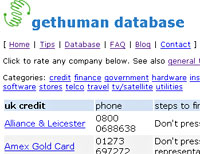 Here’s some example entries from the ‘gethuman’ UK database – obviously, we haven’t tested them all, but initial reports have been encouraging, but tell us how you got on.
Here’s some example entries from the ‘gethuman’ UK database – obviously, we haven’t tested them all, but initial reports have been encouraging, but tell us how you got on.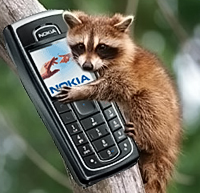 With a bonkers new naming strategy that suggests the creatives may have been on something stronger than caffeine, Orange have launched a new tariff that links customer behaviour with animal characteristics.
With a bonkers new naming strategy that suggests the creatives may have been on something stronger than caffeine, Orange have launched a new tariff that links customer behaviour with animal characteristics.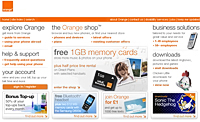 Initially launching to Pay Monthly customers, the animal packages will be made available to Pay as you go customers later in the year.
Initially launching to Pay Monthly customers, the animal packages will be made available to Pay as you go customers later in the year.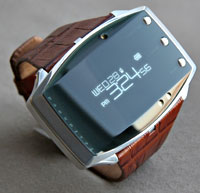 Seiko Instruments has announced their first Bluetooth watch, known as either the BT Watch or the rather less snappy, CPC TR-006 ver.1.0.
Seiko Instruments has announced their first Bluetooth watch, known as either the BT Watch or the rather less snappy, CPC TR-006 ver.1.0. If you get an SMS or email on your phone the watch can alert you, and if your phone’s ringing, you won’t have to rummage about in your bag or pockets to see who is calling – the number will appear on the watch.
If you get an SMS or email on your phone the watch can alert you, and if your phone’s ringing, you won’t have to rummage about in your bag or pockets to see who is calling – the number will appear on the watch.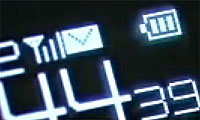 Now, much as we like the idea of cool high tech toys buzzing away on our wrists, we have to say that this watch looks more than a bit silly – it’s so big you may as well strap your mobile onto your wrist and be done with it!
Now, much as we like the idea of cool high tech toys buzzing away on our wrists, we have to say that this watch looks more than a bit silly – it’s so big you may as well strap your mobile onto your wrist and be done with it! We reckon it would be cool to have text messages, news headlines, RSS feeds, football scores and other short bursts of info appear on your watch – particularly when you’re stuck in a dull meeting.
We reckon it would be cool to have text messages, news headlines, RSS feeds, football scores and other short bursts of info appear on your watch – particularly when you’re stuck in a dull meeting.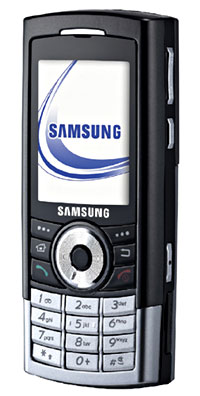 Samsung has announced the world’s first 8GB Hard Disk embedded smartphone, the SGH-i310, which is expected to start shipping in Europe during the second half of this year.
Samsung has announced the world’s first 8GB Hard Disk embedded smartphone, the SGH-i310, which is expected to start shipping in Europe during the second half of this year.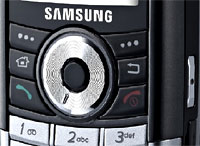 The smartphone seems pretty pocketable too, measuring 111.9 x 48.5 x 19.8 mm and weighing 120g.
The smartphone seems pretty pocketable too, measuring 111.9 x 48.5 x 19.8 mm and weighing 120g. The Big Six handset suppliers increased their rottweiler-like grip on the global mobile phone market, accounting for 84 per cent of all sales in Q4 2005.
The Big Six handset suppliers increased their rottweiler-like grip on the global mobile phone market, accounting for 84 per cent of all sales in Q4 2005.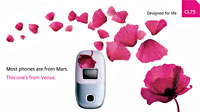 There was a veritable tango of phone flogging going down Latin America way, with sales reaching nearly 102 million units in 2005, a maraca-shaking 40 percent increase from 2004.
There was a veritable tango of phone flogging going down Latin America way, with sales reaching nearly 102 million units in 2005, a maraca-shaking 40 percent increase from 2004.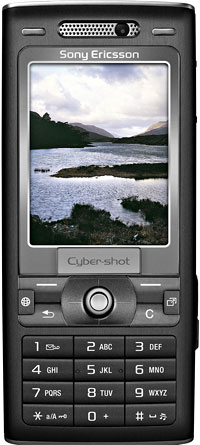 In a reflection of the growing convergence between phones and digital cameras, Sony Ericsson have declared their new K800 and K790 phones to be worthy of the Cybershot brand.
In a reflection of the growing convergence between phones and digital cameras, Sony Ericsson have declared their new K800 and K790 phones to be worthy of the Cybershot brand.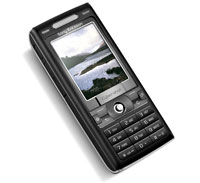 To help share your photographic masterpieces, Sony Ericsson have struck a deal with Google to enable easy photo blogging with the search engine’s Blogger service.
To help share your photographic masterpieces, Sony Ericsson have struck a deal with Google to enable easy photo blogging with the search engine’s Blogger service. Sony Ericsson have also announced two additions to the K series along with a new phone in the Z range.
Sony Ericsson have also announced two additions to the K series along with a new phone in the Z range.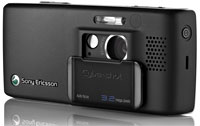 EntertainmentMusic Player (MP3, AAC, AAC+, eAAC+ support)
EntertainmentMusic Player (MP3, AAC, AAC+, eAAC+ support) More flexible than a Russian athlete in a vat of oil, Samsung’s double-flipping DMB phone offers a novel twist on the clamshell format.
More flexible than a Russian athlete in a vat of oil, Samsung’s double-flipping DMB phone offers a novel twist on the clamshell format.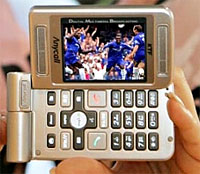 As well as the DMB functionality, the Samsung SPH-B1300 serves up the usual advanced mobile feature set, complete with a two megapixel digital camera and built-in MP3 player.
As well as the DMB functionality, the Samsung SPH-B1300 serves up the usual advanced mobile feature set, complete with a two megapixel digital camera and built-in MP3 player. We can expect more details about the Samsung SPH-B1300 to be revealed at the CeBit 2006 show in Hannover next month.
We can expect more details about the Samsung SPH-B1300 to be revealed at the CeBit 2006 show in Hannover next month.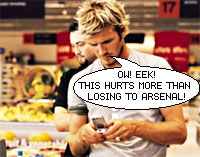 According to a new survey from Virgin Mobile, mobile telephone text messaging has become so popular in the UK that millions are complaining of injuries to their thumbs and fingers.
According to a new survey from Virgin Mobile, mobile telephone text messaging has become so popular in the UK that millions are complaining of injuries to their thumbs and fingers.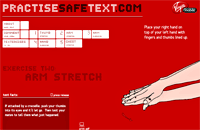 Despite the agony, it seems that Brits are prepared to go through the pain barrier to keep bashing out their texts, with more than twelve per cent admitting to sending 20 text messages a day – with a seriously obsessed ten per cent blasting out as many as 100 texts a day!
Despite the agony, it seems that Brits are prepared to go through the pain barrier to keep bashing out their texts, with more than twelve per cent admitting to sending 20 text messages a day – with a seriously obsessed ten per cent blasting out as many as 100 texts a day! Designed to highlight the very real problems of RSI, Virgin have sponsored a very useful site,
Designed to highlight the very real problems of RSI, Virgin have sponsored a very useful site, 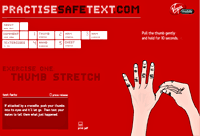 As a recent sufferer of RSI (brought on by long hours sweating over a hot Logitech as I try to bring you, dear reader, the latest stories), I strongly recommend you try out some of the exercises.
As a recent sufferer of RSI (brought on by long hours sweating over a hot Logitech as I try to bring you, dear reader, the latest stories), I strongly recommend you try out some of the exercises.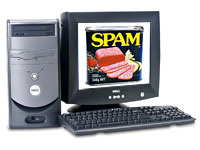 So, it’s Monday morning, you’ve sat down at your desk, powered up your PC and then slunk lower and lower in your chair as a fresh tide of spam rolls into your inbox.
So, it’s Monday morning, you’ve sat down at your desk, powered up your PC and then slunk lower and lower in your chair as a fresh tide of spam rolls into your inbox. If musing over updated spam graphs are your thing, check out the
If musing over updated spam graphs are your thing, check out the  We covered
We covered